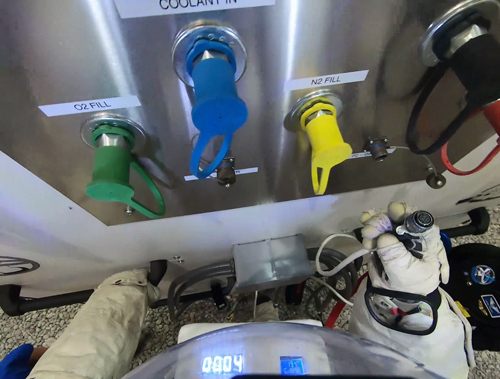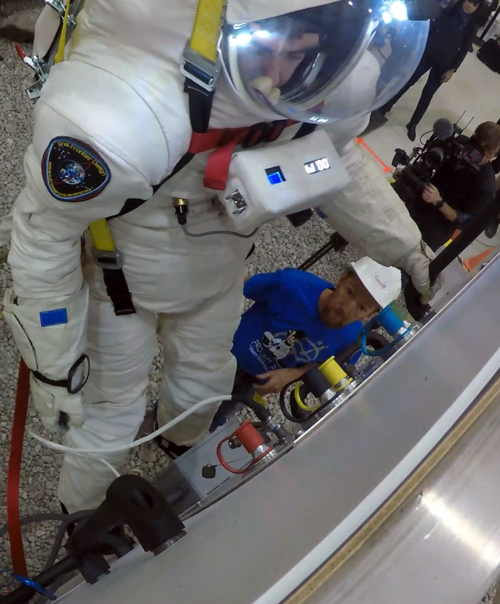Posey's Moonshot
What's It Like To Do IT Work in Space?
Between zero gravity and the cumbersome spacesuit, everyday IT tasks -- like connecting some power and data cables -- suddenly become a lot more complicated.
Whenever I attend an IT conference, there are two questions that I always get asked by attendees. First, and perhaps most predictably, I get asked what it's like to train to go to space. The second question is how in the world I went from working in IT to training to be a commercial astronaut. The funny thing is I often ask myself the same question.
To this day, I continue to work in both IT and astronautics. In many ways, the two careers could not be more different. I can't seem to ever recall doing an IT project that ended with a parachute jump into the water or fighting off crushing G forces in an effort to avoid passing out.
Every once in a while, though, there is some overlap between my two fields. A couple of years ago, for example, I did some experiments to see how well the Microsoft HoloLens would work in zero gravity. Another similarity between the two fields is that both require you to constantly be learning new (and highly technical) material. And like the world of IT, training to go to space sometimes means having to pass exams.
Sometimes my IT background comes into play in other ways. There have been times when I've had to address a computer problem or a problem with a piece of equipment such as a digital camera while flying on an aircraft and preparing to go weightless. Of course, those repairs weren't exactly planned -- they were just something that had to be done in order for the mission to continue. Since I'm the IT guy on the team, I ended up taking care of it.
Not all that long ago, though, I got the chance to find out what it would be like to do actual IT work in space.
That Pesky Zero Gravity Issue
Last fall I performed my first simulated EVA, or extravehicular activity -- basically, a spacewalk. My tasks for this particular EVA included connecting a number of fluid hoses and some power and data cables to a low-fidelity mock-up that was meant to provide a sense of what it might be like to do a repair on the outside of the International Space Station.
Going into this exercise, I felt completely confident in my abilities. After all, I have been working in IT for 30 years (I started as a teenager), and I have definitely connected my fair share of power and data cables. But what I found is that the pressurized spacesuit and the lack of gravity made the job a lot trickier than it would have been on the ground.
Before I explain why something as simple as plugging in a few data cables turned into a fairly big job, let me tell you what was actually involved in the process.
Attaching the data cables wasn't quite as simple as just plugging a cable into in an RJ-45 port. The data cables I was working with were keyed, which meant that the cables could only be inserted in one orientation. I don't know what types of cables I was working with, but I can tell you that they were similar to MIDI cables but had more pins, thus making them more difficult to insert. You can see what the cable ends look like in Figure 1. This picture was taken from a GoPro camera that I had attached to the top of my helmet.
 [Click on image for larger view.] Figure 1: This is what the cable ends look like.
[Click on image for larger view.] Figure 1: This is what the cable ends look like.
Prior to installation, the cable ends were protected by a screw-on dust cap that had to be removed. A similar cap also covered the ports that the cables were to be inserted into. You can see one of the port dust caps dangling by a short cable in the figure above. The process of attaching the cables involved removing both dust caps, finding the correct cable orientation, plugging the cable in, then using a nut to lock the cable into place once it was connected.
The first thing that made this task difficult to complete in a space analog environment was the lack of gravity. I wasn't actually weightless, but was instead strapped into a gravity offset device. It uses motors and cables to completely offset your weight, making it feel as though you are weightless. The system can also recreate lunar gravity.
Before I could start the repair, I had to grab the cable and make my way to the port where the cable was to be plugged in. This meant moving along a series of handholds and a pair of tethers to avoid floating away. Of course, I also had to hold onto the data cable as I worked the tethers. Had I let go of it, even for a couple of seconds, it would have been gone.
The other funny thing about the tethers is that they are several feet in length. This is by design, because it allows you to translate from one handhold to the next without ever having to completely unclip yourself. At the same time, though, the tether's length can make it tough to stay in place.
Once I arrived at the first data port and was tethered to the handhold, I let go of the handhold so that I could remove the dust cap from the cable. While I was unscrewing the dust cap, I ended up drifting a few feet away from the port. It's quite a trick to try to install a cable one-handed while using the other hand to hold yourself in place.
Unscrewing the dust cap can also be tricky in zero gravity. If you fail to properly anchor yourself, the cap doesn't move when you turn it. Instead, it's you who ends up moving.
The only way I was able to complete the cable installation task was to make use of foot restraints. Those restraints gave me a way to anchor myself to the module that I was working on, thereby allowing me to use both hands for the task at hand.
The other tricky part of connecting data cables in space is working against the EVA suit. I'm sure you noticed back in Figure 1 how big and bulky the gloves are. In addition to being bulky, those gloves are full of pressurized air, meaning that hand motions require a bit of effort. Initially, this extra effort doesn't really seem like a big deal, but I found that my hands eventually got tired.
Another challenging aspect of wearing an EVA suit while installing data cables is that the suit has very limited visibility. If you look at Figure 2, you will notice that there is a mirror attached to my wrist. This mirror is often the only means you have to see whatever it is that you happen to be working on.
 [Click on image for larger view.] Figure 2: EVA suits do not offer the best visibility.
[Click on image for larger view.] Figure 2: EVA suits do not offer the best visibility.
The IT 'Team' Is a Lot Bigger
Still another thing that makes IT work challenging in the context of an EVA is that you can't focus your attention solely on the task at hand. You have to multitask.
Space is a lethal environment, and your spacesuit is the only thing keeping you alive. As such, you have to keep an eye on the suit's health while you are also working on your primary objective. This means periodically checking to make sure that the suit is holding pressure, and also regulating the suit's temperature in response to changing conditions (among other things).
Finally, you also have to deal with having mission control scrutinizing your every move. During that particular simulation, I had several people keeping an eye on me. Each of them had something specific that they were concerned with. For example, the medical team was primarily concerned with my health and well-being. Likewise, there were those whose job it was to monitor the suit's status. Still others were concerned with the mission itself.
As I worked to install the cables, I was constantly receiving radio transmissions related to my work. Sometimes the instructions I received were contradictory. For example, the medical team once told me that I needed to slow down a bit because my body temperature was higher than they wanted it to be. Shortly after that, someone else indicated that I needed to pick up the pace because I only had a certain amount of time remaining.
It's a tough gig, for sure. Imagine being micro-managed by several different managers, each with their own differing priorities, and you will begin to get a sense of what an EVA is like. The one thing that keeps it from being total chaos is that only one person (the capcom, or capsule communicator) is actually able to talk to you. Everyone else's instructions have to be relayed through the designated capcom.
I haven't been to space yet, and I have no idea whether I will ever get a chance to do an EVA. In any case, my first EVA simulation was very eye-opening. Having spent my entire adult like working in IT, I wouldn't have thought that connecting data cables would have been any big deal. While I did manage to complete the task successfully, it was far more demanding than I ever would have imagined.
About the Author
Brien Posey is a 22-time Microsoft MVP with decades of IT experience. As a freelance writer, Posey has written thousands of articles and contributed to several dozen books on a wide variety of IT topics. Prior to going freelance, Posey was a CIO for a national chain of hospitals and health care facilities. He has also served as a network administrator for some of the country's largest insurance companies and for the Department of Defense at Fort Knox. In addition to his continued work in IT, Posey has spent the last several years actively training as a commercial scientist-astronaut candidate in preparation to fly on a mission to study polar mesospheric clouds from space. You can follow his spaceflight training on his Web site.